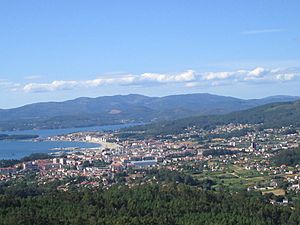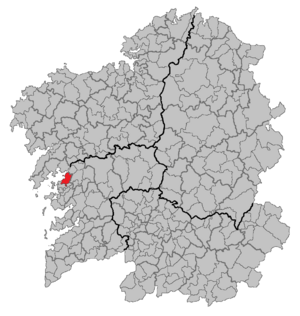Vilagarcía de Arousa facts for kids
Quick facts for kids
Vilagarcía de Arousa
|
|||
|---|---|---|---|

Vilagarcía de Arousa
|
|||
|
|||
| Nickname(s):
Vilagarcía
|
|||

Location of Vilagarcía de Arousa within Galicia
|
|||
| Country | |||
| Autonomous Community | |||
| Province | Pontevedra | ||
| Comarca | O Salnés | ||
| Government | |||
| • Type | Concello | ||
| Area | |||
| • Total | 47.14 km2 (18.20 sq mi) | ||
| Population
(2018)
|
|||
| • Total | 37,519 | ||
| • Density | 795.91/km2 (2,061.39/sq mi) | ||
| Demonym(s) | Vilagarciano | ||
| Time zone | CET (GMT +1) | ||
| • Summer (DST) | CEST (GMT +2) | ||
| Post code |
36600
|
||
| Patron saints | Santa Rita (22 May) San Roque (16 August) | ||
Vilagarcía de Arousa is a lively town located in the province of Pontevedra, within the region of Galicia, Spain. As of 2014, it was home to about 37,712 people, making it the ninth largest town in Galicia. It's a great place to learn about history, geography, and fun local traditions!
Contents
A Look Back: Vilagarcía's History
Vilagarcía de Arousa has a very long and interesting history. People have lived here since prehistoric times, which means thousands of years ago!
Ancient Discoveries
- Stone Age Art: You can find ancient rock carvings, called Petroglyphs, in the area of Bamio. These carvings show circles or even deer shapes and are about 4,000 years old.
- Old Settlements: Places like Alobre, Carril, Agudín, and Lobeira were once "castros." These were old fortified villages.
- Roman and Visigothic Finds: Archaeologists have found coins from the Romans and the Visigoths. This tells us that people continued to live and trade in this area for a very long time.
Exploring Vilagarcía: Geography
Vilagarcía de Arousa is located in a special part of Spain called O Salnés. It sits right on the edge of a large sea inlet known as the Ría de Arousa.
Where is Vilagarcía Located?
- Coastal Town: It's at the very southern end of the Ría de Arousa, which is like a long, narrow arm of the sea reaching inland.
- Neighboring Towns: To the north, it shares a border with Catoira. To the east, you'll find Caldas de Reis, and to the south, it borders Vilanova de Arousa.
- Close to Santiago: Vilagarcía is about 45 kilometers (28 miles) south of the famous city of Santiago de Compostela.
How the City is Divided
Like many places in Galicia, Vilagarcía is split into smaller areas called parroquias. Think of them as neighborhoods or districts within the municipality. Here are some of them:
- Arealonga (Santa Eulalia de Afora)
- Bamio (San Xinés)
- Carril (Santiago)
- Cea (San Pedro)
- Cornazo (San Pedro)
- Fontecarmoa (San Pedro)
- Rubiáns (Santa María)
- Sobradelo (San Salvador)
- Sobrán (San Martín de Afora)
- Solobeira (San Félix)
- Vilagarcía (Santa Eulalia e A Nosa Señora de la Junquera)
- Carril (Santiago de Afuera)
The Important Port of Vilagarcía
The port in Vilagarcía de Arousa is a huge part of the town's economy. It covers a large area, about 566,874 square meters!
History of the Port
The port's activities started way back in the mid-1800s. It actually grew from an older, busy trading spot called Carril. Carril was so important that many countries, like Great Britain, Portugal, and Germany, even had special offices there to handle trade.
What the Port Does Today
Today, the port is a key place for:
- Shipping Goods: It's used to send goods out (export) and bring goods in (import).
- Fishing: Many fishing boats use the port.
- Fun Activities: It's also a spot for leisure activities, like boating.
Fun Times: Festivals in Vilagarcía
Vilagarcía de Arousa is known for its exciting festivals! These are great times for locals and visitors to celebrate.
Main Festivals
- Festivals of Santa Rita (May 22)
- Festival of San Roque (August 16)
- Festival of the Ameixa (Clam) of Carril
The San Roque Festival and the "Water Festival"
The biggest festival in Vilagarcía de Arousa is the Patron Saint festival for Saint Roch (San Roque). It lasts for 10 days around August 16th.
How the Water Festival Works
On August 16th, two main events happen:
- Religious Procession: First, there's a church service, and then a procession. People carry a statue of Saint Roch from the main church to his chapel. Thousands of people walk along, moving to the beat of a special Spanish song called a Triunfo paso doble.
- The Festa da Auga (Water Festival): After the procession, the real fun begins! Thousands of people, young and old, run through the streets shouting "¡agua!" (water!). People living in the houses above throw water down from their windows using buckets and hoses. The goal is to get everyone soaking wet! Even the city firefighters join in, spraying water from their trucks. This huge water fight can last until evening. There's even a special "wet area" in the main streets where getting drenched is expected and welcomed. Around 20,000 to 30,000 people usually take part in this amazing water festival!
Famous Faces from Vilagarcía
Many talented people come from Vilagarcía de Arousa. Here are a few notable individuals:
- Dani Abalo, a footballer
- Laura Alonso, an opera singer
- Manuel Bernárdez, a diplomat and writer from Uruguay
- Jéssica Bouzas Maneiro, a tennis player
- Gustavo César, a cyclist
- Luis César Sampedro, a footballer
- Pablo Coira, a footballer
- José Fontán, a footballer
- Manuel Jiménez Abalo, a footballer
- Antón Paz, a sailor who won a gold medal at the 2008 Summer Olympics
- Pepe Rubianes, an actor
- Mari Paz Vilas, a footballer
Friendly Connections: Sister Cities
Vilagarcía de Arousa has a special friendship with another city. This is called being "twinned" or a "sister city."
 Matosinhos, Portugal
Matosinhos, Portugal
See also
 In Spanish: Villagarcía de Arosa para niños
In Spanish: Villagarcía de Arosa para niños



